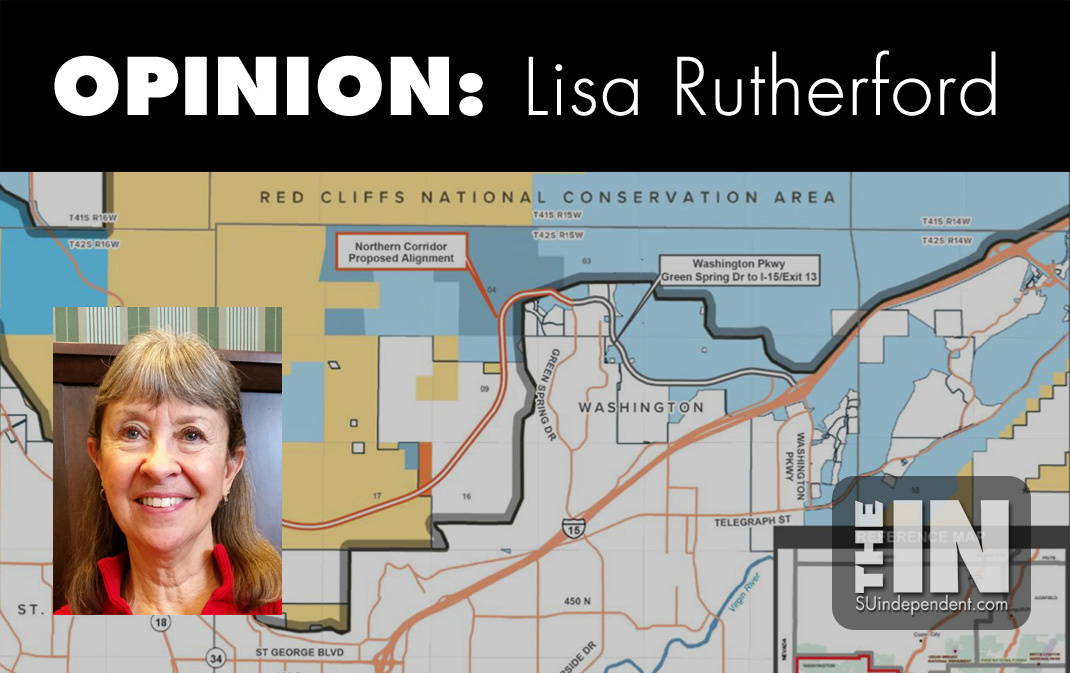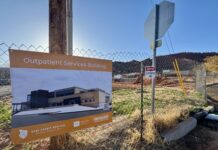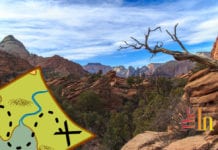
Thoughts on the Northern Corridor Highway and growth in Washington County
– By Lisa Rutherford –
Since 2006, I’ve been tracking the proposed Northern Corridor Highway, also called Washington Parkway by the county. Washington County officials have asserted the highway is needed to support growth and the traffic that Washington County’s extreme growth will produce.
But new data from the Kem C. Gardner Policy Institute reveal that growth in Washington County from 2022 to mid-2023 actually slowed from prior years. According to an article in The Spectrum & Daily News, the growth during the time period “was significantly slower than in some previous years.” In fact, it was “growing about half as fast as it was from 2020 to 2021.” Washington County’s mid-2023 population was 198,533 according to the institute’s report. That’s less than what was projected in the studies supporting the Lake Powell Pipeline (LPP). Washington County’s growth rate was 2.4% during the period reviewed while the LPP studies projected a 3.6% annual growth rate.
Why am I mentioning this? Because a federal court recently ruled that the agencies that in 2021, at the end of the Trump administration, approved a UDOT right-of-way for the highway through Red Cliffs National Conservation Area / Reserve must now revisit that decision in light of the poor analysis done by the agencies. A public comment period on the matter is currently underway with comments due by December 28.
At the December 6 public meeting conducted by the BLM and U.S. Fish and Wildlife it was made clear to me that issues such as area economics and more will be revisited as the agencies create a supplemental environmental impact statement (EIS).
This issue is complex; that is clear. But at the heart of the matter is the county’s unfounded assertion that the Northern Corridor is needed to help manage traffic, and traffic projections are based on population projections. With growth slowing in the area, as revealed by the Gardner Policy Institute information, perhaps the agencies will see that the highway is not needed as much as the county and UDOT assert.
The 2020 Draft EIS and Final EIS contain a report titled “Highway Alternatives Development Technical Report” (May 2020) by Jacobs, an engineering firm. Two alternatives – Red Hills Parkway Expressway and St. George Boulevard/100 South One-way Couplet – perform as well or better than UDOT’s and the county’s preferred route through Red Cliffs Zone 3. Apparently, the agencies ignored this information or, at best, gave it short-shrift when making their final decision in 2021. The table (Table 4. Transportation Analysis: 2050 Evening Peak Hour Intersection LOS Results) provided by Jacobs is a transportation analysis projected out to 2050 for evening peak hour intersections congestion.
The traffic analysis is not the only reason to reject the idea of stabbing a highway through the heart of Red Cliffs, one of three National Conservation Areas (NCA) in Utah, and a national treasure which we should be protecting for the benefit of the threatened Mojave desert tortoise population, not using as a dumping ground for our perceived traffic challenges. Approval of this highway would set a terrible precedent for all other NCAs in this nation.
Additionally, Land and Water Conservation Funds (LWCFs) were used to purchase acres in Red Cliffs. LWCFs are for protection and recreation purposes, not highways. These are our federal tax dollars being used improperly.
Nearly 15,000 acres within Red Cliffs were burned in summer 2020. 9,000 acres of tortoise critical habitat were affected. This occurred as the agencies were finalizing the EIS, and in a rush to complete the EIS, a thorough analysis of the effects of the fires had not been undertaken. In addition to doing a thorough analysis of the fires’ effects, an analysis of future fire risk is needed, too. Officials and UDOT who promote the right-of-way through Red Cliffs assert that it would act as a fire break, but evidence shows that roads create fire potential. Several years ago, California fires jumped major roads and highways revealing they are not effective fire breaks. After the 2020 fires that decimated Red Cliffs, there was much discussion at Washington County Habitat Conservation Committee meetings about how to deal with vehicle-caused fires. Stopping the NC would be one very good way.
Another matter that deserves consideration is the creation of Zone 6. Red Cliffs had five zones before the 2020 EIS was approved. That approval created Zone 6 in a popular recreation area on the west side of Washington County that also has a significant number of tortoises. The county is making a point of threatening that Zone 6 would not be protected if the right-of-way for the highway through Red Cliff’s Zone 3 is not approved. However, before Zone 6 was approved, a large portion of the area is BLM land that was already protected and would retain that protection. The remaining land that’s owned by SITLA could be developed, but that was the case before Zone 6 was approved. Trading land in Zone 3 for the NC by creating a new Zone 6 is not reasonable. In fact, given the ages of the tortoises surveyed in Zone 6, that area should have been included in Red Cliffs when it was originally established not used as a bargaining chip now.
I appreciate the fact that many love the recreation opportunities Red Cliffs affords. When enacted, the 2009 Omnibus Public Land Management Act – which made 45,000 acres of the 62,000 acre Red Cliffs Reserve a National Conservation Area – made it clear that the purpose of Red Cliffs National Conservation Area was “to conserve, protect, and enhance, for the benefit and enjoyment of present and future generations, the ecological, scenic, wildlife, recreational, cultural, historical, natural, educational, and scientific resources of the National Conservation Area.” But, the reason Red Cliffs Desert Reserve was established in 1996 was to protect the Mojave desert tortoise, not protect recreation. We can do both with good decisions, but tortoise protection should be first and foremost.
Perhaps the thing that irks me most is the blatant way the county is ignoring the work done and decisions made leading to the 1996 establishment of Red Cliffs Desert Reserve, now mostly Red Cliffs NCA. As we grow, even if, as mentioned at the beginning of this article growth has slowed somewhat, we should honor hard-fought decisions made in the past – decisions that honored agreements made to protect the area for the benefit of the threatened Mojave desert tortoise. There’s no honor in using growth – growth that was predicted even in the 90s – to justify backpedaling on agreements made and attempting to misinterpret legislation passed since then to create a new scenario.
For those who love Red Cliffs and want its legacy honored, now is the time to comment during the scoping period that ends December 28. Conserve Southwest Utah has provided an easy way to make your voice heard. Go to https://www.protectredcliffs.com/. Or, you can go to the BLM National NEPA Register: https://eplanning.blm.gov/eplanning-ui/project/2026562/510. Please be part of Washington County’s future!
Viewpoints and perspectives expressed throughout The Independent are those of the individual contributors. They do not necessarily reflect those held by the staff of The Independent or our advertising sponsors. Your comments, rebuttals, and contributions are welcome in accordance with our Terms of Service. Please be respectful and abide by our Community Rules. If you have privacy concerns you can view our Privacy Policy here. Thank you!
Click here to submit an article, guest opinion piece, or a Letter to the Editor





Well said, Lisa. The Jacobs report to which you refer made clear that there are two alternative routes that are somewhat better at meeting 2050 traffic demands than the route through the NCA. Furthermore, both would cost significantly less than the NCA route. We can have our cake and eat it too: traffic needs met at lower cost. What’s not to like?
Thank you for your take on my opinion piece, Howard. As an engineer, it’s clear you see the value of the engineering report that supports other alternatives. We can only hope that the new Supplemental EIS provides the same analysis. When it comes to these things, it’s difficult to predict what pressure will be put on this issue again. Happy Holidays to you!
Red Hills Parkway was designated as the Northern corridor during the hearings in the early 90’s. There was to be no other roads. Back then when Redhills Parkway was Skyline Drive the turtle road was constructed to set the road through the reserve. If I recall, Dr Booth was instrumental in this concession.
Kris, my understanding is that the turtle road was already in the area. Red Hills Parkway is the only road that was approved for future expansion, however. That’s why it should be considered instead of any other Northern Corridor routh through Red Cliffs. You are right that there were to be no other roads. Dr. William Mader, who was the first administrator of Red Cliffs, was involved in all these early discussions and can attest to this. He’s been adamant that the Northern Corridor should never be built through Red Cliffs.
It doesn’t seem to to provide that much advantage over current routes. I love the recreation opportunities up there. The tortoises are critical too.
I agree on all points, Ben!